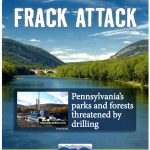Frack Attack: Pennsylvania’s parks and forests threatened by drilling
Pennsylvania is blessed with incredible public lands, from the famed hiking paths and scenic vistas of Loyalsock and Cook State Forests, to the pristine woods and walking trails of the Delaware Water Gap. Unfortunately, many of these places are under threat from fracking.
Downloads
PennEnvironment Research & Policy Center

Pennsylvania is blessed with incredible public lands, from the famed hiking paths and scenic vistas of Loyalsock and Cook State Forests, to the pristine woods and walking trails of the Delaware Water Gap. These parks and forests are the destinations for millions of Pennsylvanians and visitors from around the globe who want to take advantage of the Commonwealth’s great public lands for hiking, biking, fishing, or just to get away from it all.
Each year, 35 million visitors trek to Pennsylvania’s state parks. Estimates are that when local and county parks are included, this number increases substantially. Federal public lands, such as the Delaware Water Gap, boast over 9 million visitors in Pennsylvania as well. All told, Pennsylvania has over 2.2 million acres of state forestland, 120 state parks cover- ing 330,000 acres, and more than 18 national parks. These places aren’t simply critical natural and recreation areas; they are also important drivers of our local economies—the Commonwealth’s state park system provides approximately 13,000 quality jobs to Pennsylvania’s residents, and contributes 1.2 billion dollars to the state’s economy.
Our public lands are arguably Pennsylvania’s greatest natural treasure, and they must be protected for future generations to enjoy and embrace. Unfortunately, more and more of Pennsylvania’s public lands are under siege from the growing threat of the oil and gas drilling process known as “fracking.”
Across Pennsylvania, 1.5 million acres of forestlands, comprising 18 of the 20 state forests, and 61 state parks sit atop the Marcellus Shale gas formation.
Sadly, politicians from both sides of the aisle—Democrats and Republicans alike—have used their positions of power to press for opening up these public lands, turning them into cash cows for state coffers instead of protecting them from harmful fracking activities. All told, 700,000 acres of state forestland is available for drilling due to either privately owned oil and gas rights, or because of acreage leased by PA-DCNR. The fracking industry and its political allies have also set their sights on county and state parks.
And while the full-court press to open up public lands to fracking is just beginning, the effects have already been disastrous—pipelines dissect state forestlands; spills of toxic fracking waste water have polluted pristine streams that crisscross through public lands; roads and well pads lead to run-off pollution in nearby forestlands; and massive amounts of truck traffic are creating air and noise pollution—all in what were once peaceful places where Pennsylvanians went to recreate and enjoy nature.
Already Pennsylvania has seen nearly 1,500 acres of publicly-owned state forestland converted to roads, pipelines, and well pads for fracking. This not only damages the physical beauty and integrity of landscapes, but can have profound impacts on their economic value for tourism and recreation. Moreover, fracking can destroy and degrade the pristine streams and rivers that crisscross our public lands. From excessive water withdrawals to contamination from fracking chemicals and other pollution, the waterways that are the backbone of many parks and forests are at risk—putting local outdoor-related economies further at risk.
Despite all this, on May 23, 2014, Gov. Tom Corbett announced his decision to lift the four-year moratorium on further leasing of state forestland. Incredibly, Gov. Corbett’s executive order goes even further to allow drilling under our state parklands—an unprecedented decision for public lands that have specifically been spared from extractive purposes.
Pennsylvanians must protect our great public lands from the threat of fracking. Be it public lands under local, state or federal jurisdiction—from county parks, state parks and forests or parts of our national park service—drilling in these places will inevitably lead to the destruction of wild forests, the loss of essential habitat for native plants and wildlife. And in turn this means the further degradation of the ecological and recreational value to the best parts of Pennsylvania’s natural heritage and outdoors.
To demonstrate the threat facing Pennsylvania’s public lands from fracking, PennEnvironment Research & Policy Center has cataloged five compelling examples of public lands in the Commonwealth that face a growing risk from fracking—a risk that would do irreparable harm to the places that millions of Pennsylvanians love and cherish.
While highlighting five beloved places in this report, sadly, there are many more local, county, state and federal lands that are beloved and wild—and facing the encroaching threat of fracking.
If we cannot preserve the special places that we’ve been charged with protecting for future generations, there will be no place that is off limits to the drillers.
The five special public places highlighted in this report include:
1. Loyalsock State Forest
2. Ohiopyle State Park
3. Delaware Water Gap National Recreation Area 4. Deer Lakes Park, Allegheny County
5. Cross Creek County Park, Washington County
Our parks, forests and public lands must be protected from fracking and its web of destructive activities. We cannot allow our elected officials to use them as cash cows over the short term and in turn leave a legacy of irreparable harm forever.
